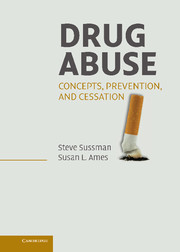Book contents
- Frontmatter
- Contents
- Preface
- Acknowledgments
- SECTION ONE CONCEPTS AND CLASSES OF DRUGS
- SECTION TWO ETIOLOGY
- 4 Current Multivariable Models
- 5 Neurobiologically Relevant
- 6 Cognitive Processes
- 7 Social Interaction and Social Groups
- 8 The Large Social and Physical Environment
- 9 Assessment
- SECTION THREE PREVENTION
- SECTION FOUR CESSATION
- SECTION FIVE CONCLUSIONS AND THE FUTURE
- References
- Author Index
- Subject Index
4 - Current Multivariable Models
Published online by Cambridge University Press: 18 December 2009
- Frontmatter
- Contents
- Preface
- Acknowledgments
- SECTION ONE CONCEPTS AND CLASSES OF DRUGS
- SECTION TWO ETIOLOGY
- 4 Current Multivariable Models
- 5 Neurobiologically Relevant
- 6 Cognitive Processes
- 7 Social Interaction and Social Groups
- 8 The Large Social and Physical Environment
- 9 Assessment
- SECTION THREE PREVENTION
- SECTION FOUR CESSATION
- SECTION FIVE CONCLUSIONS AND THE FUTURE
- References
- Author Index
- Subject Index
Summary
Let us assume there is agreement on what the constituents of problem drug use are. The previous chapters suggest that although there is some variation in what might encompass problem drug use, there is some consensus that negative consequences to the individual or to society as a function of drug intake characterize problem drug use. Certainly, drug misuse is a multifactorial biopsychosocial problem; that is, the pathways to problem drug use are complex and cannot be explained by simple cause-and-effect models. Researchers have provided evidence for numerous predictors of drug use and misuse. Some predictors are within the individual (e.g., genetics, brain systems and structures, and cognitive processes), which one might label as biological or psychological in focus, and some predictors occur in the individual's environment. These latter social and physical environment-type processes may occur in small social groupings and interactions, or they might encompass a large social and physical environmental climate and entail such variables as drug distribution routes and defensible space. Increasingly, researchers have moved toward more “complex, dynamic, multidimensional, level/phase structured, nonlinear, and bounded (culture, time, place, age, gender, ethnicity etc)” underpinnings of substance use behavior (Lessov et al., 2004, p. 1519). Consequently, several different integrated substantive models of substance abuse have been developed.
This chapter presents examples of current multivariable etiologic models of drug abuse. Subsequent chapters explore more deeply the components of these models and, as a result, may help the reader discern for him- or herself the adequacy of the current multivariable models.
- Type
- Chapter
- Information
- Drug AbuseConcepts, Prevention, and Cessation, pp. 57 - 68Publisher: Cambridge University PressPrint publication year: 2008



